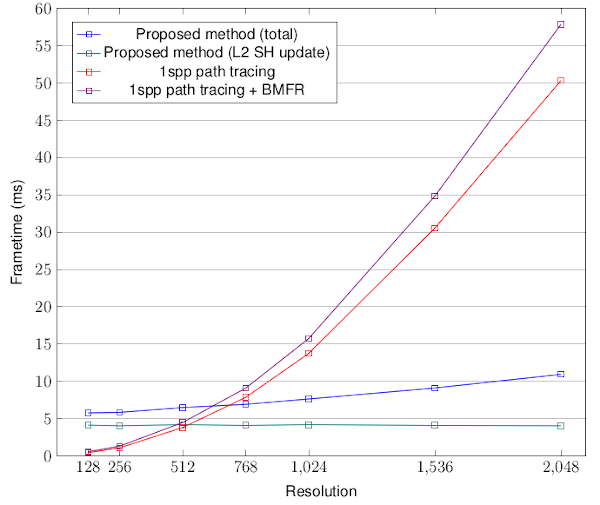Real-Time Path Traced Spherical Harmonics Probes
2020, Ikkala, J., Master of Science thesis, Tampere University.

Abstract: Virtual reality headsets and light field displays are relatively new display technologies that are becoming more commonplace. They pose problems because of the extremely high number of pixels that they require to be rendered at relatively high framerates. Simultaneously, the latest high-end GPUs contain acceleration hardware for ray tracing, which enables photorealistic rendering algorithms such as path tracing to be used in real-time to a limited extent. Using the computational power of these power-hungry devices over a network connection can enable more realistic graphics in mobile devices as well.
This thesis proposes a novel hybrid real-time computer graphics rendering algorithm that is particularly well-suited for distributed computing and reproduces indirect lighting phenomena. The algorithm works by computing and storing lighting state at specified points in space, called light probes. These probes are calculated and updated using path tracing, which is a highly realistic light simulation algorithm, during the runtime of the program. Light probes solve the issue of indirect lighting in the rendering pipeline; direct lighting is computed using lightweight rasterization-based rendering.
In the proposed rendering method, the heavy-to-compute indirect lighting part of the rendering pipeline is highly independent of the rest of the pipeline and can be offloaded to a powerful server, leaving the client device with only the lightweight rasterization workload. This allows low-powered devices, such as wireless virtual reality headsets with built-in rendering capabilities, to render highly realistic and dynamic 3D content. The independence of the indirect lighting component from the rest of the system also benefits light field rendering and other multi-viewport rendering, as the intensive indirect lighting computation can be shared between all viewports and only the lightweight rasterization has to be duplicated.
Additionally, a new technique for computing approximated specular lighting from spherical harmonics light probes is proposed. This method applies the split-sum approximation to spherical harmonics and allows for fast approximation of specular lighting for materials with varying roughness. With this technique, the proposed method is able to include both the diffuse and specular lighting components of indirect lighting.
Compared to single-sample-per-pixel path tracing with state-of-the-art denoising, which is another realistic real-time rendering pipeline option, the proposed method achieves greater quality as measured by PSNR in each of the three scenes tested and the effect of increasing resolution reduces performance significantly less.